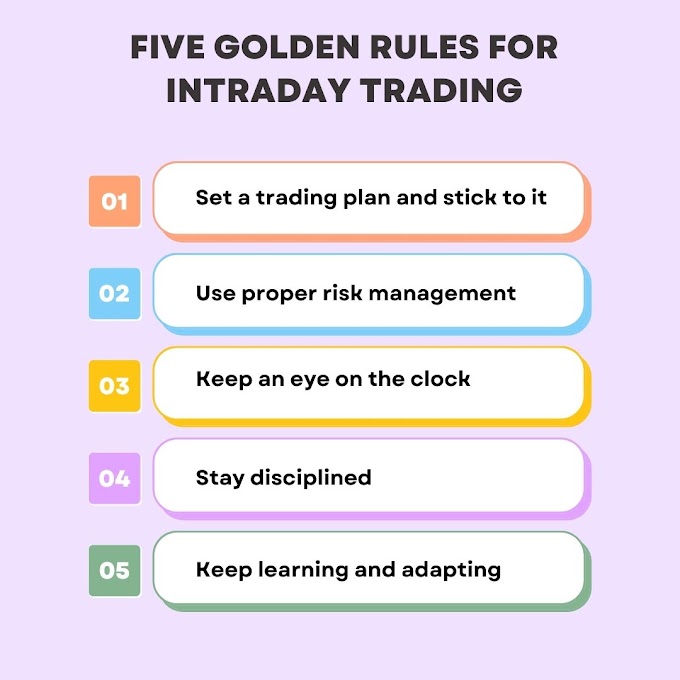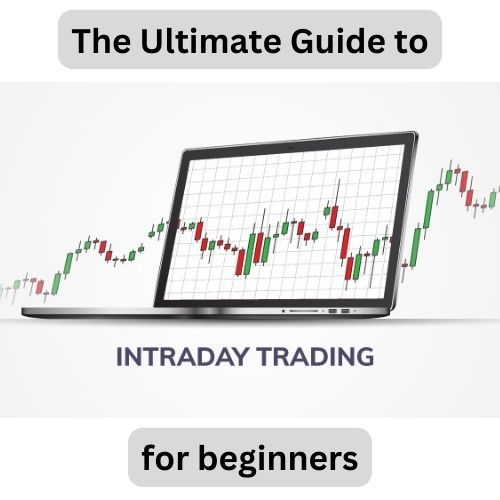The technique of buying & selling stocks during the same trading day is known as intraday trading. The stock market can be a prestigious place to gain money, but it need a lot of expertise and dedication to accomplish it very well. We'll talk about "Golden rules for intraday traders" in this article to assist you minimise risk and increase your chances of success.
Five Golden Rules for Intraday Traders
Set a trading plan & stick to it
The most important rules of intraday trading is to have a very clear trading plan in place before entering any trade. Entry and exit locations, stop-loss orders, and profit objectives should all be included in this plan. The strategy should be founded on in-depth investigation and analysis, and it should consider the trader's risk appetite and trading approach. Once the strategy has been set up, it is crucial to follow it and resist from changing it. It may be tempting to act on emotional judgements while the market is moving quickly, but doing so is a definite way to lose money. No matter what the market does, successful intraday traders know how to maintain discipline and stick to their plan.
Use proper risk management
Intraday trading involves high risk, so it's important to manage risk properly. This means using stop-loss orders to limit potential losses and never risking more than a small percentage of your trading capital on any single trade. One common guideline is to never risk more than 1% to 2% of your trading money on a single transaction. In addition to avoiding losses, risk management also aims to protect capital. Skilled intraday traders never allow their emotions to influence their decisions and know when to take profits and when to cut losses.
Keep an eye on the clock
Intraday traders need to be aware of market hours and how they can impact price movements. For example, the first and last hours of trading tend to be the most volatile, while lunchtime lulls are common. Traders should adjust their strategies accordingly and be prepared for different market conditions throughout the day.
It's also important to be aware of economic events and news releases that can impact the market. For example, the release of earnings reports or economic data can cause sudden price movements, and traders need to be prepared to react quickly.
Read More Intraday Trading
Stay disciplined
Discipline is essential for intraday traders. It's simple to get carried away in the excitement of volatile global markets, but effective traders know how to maintain discipline and focus.This means sticking to their trading plan, avoiding impulsive decisions, and not letting their emotions drive their decision-making. Discipline also means taking breaks when needed. Intraday trading can be intense, and traders need to take breaks to recharge and refocus. Taking breaks can help traders avoid making impulsive decisions and keep their emotions in check.
Keep learning and adapting
Successful traders must modify their techniques to reflect the ongoing changes in the stock market. This means staying up-to-date on market news and trends, and continuously evaluating their performance to identify areas for improvement. Intraday traders should always be looking for ways to improve their strategies and techniques. This could involve reading books and articles on trading, attending seminars or webinars, or even working with a mentor or coach.
Conclusion
Intraday trading can be a challenging ,tough,complexing, emotionally draining.But by following these five rules, intraday traders can manage risk, improve their chances of success, and achieve their trading goals. Remember, successful intraday trading requires discipline, focus, and continuous learning and adaptation. Intraday trading can be or can not be a challenging depend on person to person but rewarding way to make money in the stock market. By following these five rules, intraday traders can manage risk, improve their chances of success, and achieve their trading goals. Remember, successful intraday trading requires discipline, focus, and continuous learning and adaptation.
FAQ
Q:What is 1 2 3 trading rule?
A:The 1 2 3 trading rule is a pattern used in technical analysis to identify potential reversals in price trends. The pattern consists of three consecutive peaks or valleys, with the middle peak or valley being the highest or lowest, respectively. Once the pattern is identified, traders may enter a position when the price breaks above or below the middle peak or valley.
Q:What is the 2 rule in intraday trading?
A:First rule is Set a trading plan & stick to it and second is use proper risk management.
Q:Can I sell intraday anytime?
A:You can sell your stocks if you think the market is strong or the value of your holdings is sufficient for trading, allowing you to profit.
Q:What is the maximum intraday limit?
A:The sum you decide to utilise for intraday trading is unrestricted. Nevertheless, there are limitations on margin trading that set a daily cap on how much risk a trader may expose themselves to.







